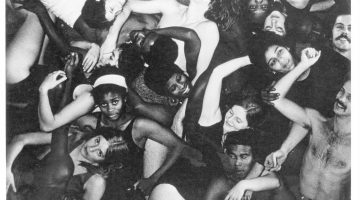By John Held, Jr.
The guy who made me (and a lot of other people) an artist died on Tuesday, April 29th, 2008 at the age of 102.
Forty years earlier, in 1968, I was an English and Theater major at a college in Upstate New York. In an effort to bring innovative theater to the hinder lands, the theater director of the school invited the Open Theater, an innovative New York City company under the direction of Joseph Chaikin, to perform, “The Serpent,” a self described “ceremony” written by Jean-Claude van Itallie.

“The Serpent”
Written by Jean-Claude van Itallie.
In collaboration with the Open Theater.
Directed by Joseph Chaikin.
The playwright wrote of the piece that theater was a, “religious function of bringing people together in a community ceremony where the actors are in some sense priests or celebrants, and the audience is drawn to participate with the actors in a kind of eucharist.”
My eucharist (spiritual communication) for the evening was enhanced by doses of LSD and synthesized psilocybin, both of whose properties were discovered by Albert Hofmann. LSD (lysergic acid diethylamide) in 1943 and synthetic psilocybin (the active component of psilocybin mushrooms) in 1958.
Jean-Claude van Itallie went on to describe that the priority of the playwright is to understand, “what is happening between the audience and the action. At each point in constructing the ceremony the playwright must say to himself: ‘What is the audience experiencing now? At what point are they on their journey and where are they to be brought to next.’ The ‘trip’ for the audience must be as carefully structured as any ancient mystery or initiation. But the form must reflect contemporary thought process.”
That evening I became an artist. I was literally transformed by a combination of the actor’s powers of transmutation and the ingested chemicals ability to enhance the situation. I witnessed first hand the power of art to change lives, and I have since striven to replicate the experience in myself and others.
Albert Hofmann died Tuesday, April 29, 2008, at the age of 102. As Hoffman acknowledged in his 1979 book titled, “LSD: My Problem Child,” his discovery was both blessing and curse. While I was having my epiphany in the theater, a friend of mine was wandering around campus without his eyeglasses, convinced they were a hypocritical convenience denying him his true, albeit diminished sight. I became aware of the everyday world’s shortcomings myself during this period, convinced I was living a less than authentic life as my vision in the theater suggested I could. I was “cured” after reading “Winesburg, Ohio,” by Sherwood Anderson, who suggested that the high moral tone of the town’s inhabitants were not saintly, as they supposed, rather they became “grotesque” caricatures of themselves.
As stated in his obituary in the New York Times, Dr. Hofmann had an epiphany as a child that there was a union uniting humanity and nature, and during the course of his chemical experimentations, happened upon LSD, which reinforced this conclusion. He had gained his Ph.D. in 1929 at the age of 23, beginning work at Sandoz Laboratories in Switzerland, where he was born and continued to live. Experimenting with the synthesizing of medicinal plants, he began working with ergot fungus, which grows in rye plants and is thought to have encouraged hallucinations in Salem, Massachusetts, which concluded in the Salem witch trials of 1692.
Closer to home, the writer Ken Kesey, who enrolled in the creative writing program of Stanford University in 1958, was introduced to LSD, along with other psychoactive drugs, in a CIA financed study at the Menlo Park Veterans Hospital. Continuing his private experimentation with the drug, he began sharing the experience with friends in drug induced rituals he called Acid Tests. Those involved included his favorite band, then known as The Warlocks, later as The Grateful Dead. Their exploits, along with Tom Wolfe’s popular culture account of their activities, “The Electric Kool-Aid Acid Test” (1968), spread the popularity of the drug throughout youth culture, as far as the theater of my college in Upstate New York.
LSD was, of course, demonized in the popular press at the time, said to cause psychotic reactions and death. But others, like Aldous Huxley, who wrote about his use of psychoactive drugs in, “The Doors of Perception” (1954), found them to be a useful search for enlightenment. By fathering the most powerful psychotropic substance of them all, Albert Hofmann, and his adherents like Kesey and Timothy Leary, paved the way for generations of youthful followers who found it a revelatory aid in contemplating understanding of the world in which we live, and wish to live in.
Obituary in the New York Times: http://www.nytimes.com/2008/04/30/world/europe/30hofmann.html?_r=0
Obituary in the Los Angeles Times:http://articles.latimes.com/2008/apr/30/local/me-hofmann30








